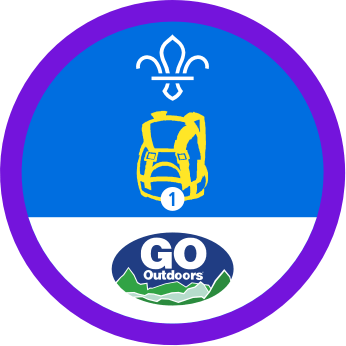Hiking
What to expect
Hiking’s versatile: you can change it up to suit your group. It doesn’t have to involve mountains or treacherous terrain. You could take to the pavements of your local area, countryside footpaths, or forest tracks.
It’s also up to you what you do on the way. The beauty of hikes is that there’s no rush – it’s not all about the end destination, it’s about the journey you take to get there too. Some people like to get stuck in to being mindful of the world around them, while others add extra challenges or activities. You could visit a local landmark (or two), learn how to navigate, or hide treasure for another team to find.
No two hikes are the same. Sometimes you’ll get lost, sometimes the weather might catch you out, and sometimes you’ll feel tired – the important thing is that you stick it out. You’ll learn a lot about yourself along the way.
Fun facts
Grandma Gatewood (also known as Emma Rowena Gatewood) was inspired by an article in National Geographic to become the first woman to solo-hike the entire Appalachian Trail in one season. She did it in 1955, when she was 67 years old. She then became the first person to conquer it more than once!
Handy hints
- Wear your boots in before you set off. Wear new hiking boots plenty of times before you head off on a hike. If you wear boots straight off the shelf, they’re likely to be too stiff and rub your feet and ankles. No one wants blisters.
- Don’t rely on apps. It’s great to try out some of the phone apps designed to help you make the most of your outdoor experience. Never put yourself in a situation where you rely on apps, though – even the best technology lets people down sometimes. Always take a physical map and a compass (and make sure you know how to use them).
Safety
You must always:
- Complete a risk assessment
- Have the right ratios of number of adults to provide suitable supervision
- Set up an InTouch process
- Know what to do in an emergency
- Share information with parents and carers with an activity information form
- Get approval from your commissioner
Be safe outdoors:
- Check the weather forecast
Hill walking:
- When in terrain 1 or 2 always leave a route plan with someone responsible, and all party members must carry an emergency card.
- The terrain environments are defined in POR 9.12.7, check the definition before planning your activity.
- Keep within the specified party sizes.
Joint activities with other organisations:
- This activity can be run jointly with Girlguiding.
- This activity can be run with other organisations.
This activity can be led by you or someone else in Scouts:
The activity leader must have an adventurous activities permit with the right level and permissions for your group.
You don't need a permit for activities in Terrain Zero.
Where the group is entirely members over the age of 18 the permit scheme does not apply, please follow the rule 9.8 adult groups.
You can go to a centre or use an activity leader who is not part of Scouting:
You must find a suitable provider who meets the following requirements:- The centre/instructor should hold one of these: (If the provider is AALA exempt)
- Mountain Training - Walking Group Leader (WGL)
- Mountain Training - Mountain Leader (ML)
The provider must have public liability insurance.
Guidance
Reflection
The pace and rhythm of hiking outdoors means it’s a great chance to chat and reflect. Could people chat about how hiking helps them value the outdoors? They could think about what they notice with their senses, how they make sure not to harm the outdoors while hiking, and how it feels to be connected to nature. People may also want to talk about wellbeing – does hiking help?
- You can change the distance and terrain of a route. You can also make it easier or trickier to navigate using maps.
- You can also add different checkpoints and tasks into a hike.
- Hiking can often be adapted so more people can give it a go.
- Choose routes that are suitable for everyone, and think about the terrain too. Sites such as The Outdoor Guide provide information about routes that are suitable for wheelchair users.
- Think about how everyone will get to the start point of your hike – are there accessible public transport links, or is there suitable parking nearby? What about other facilities, such as accessible toilets?
All Scout activities should be inclusive and accessible.
If people enjoyed hiking, why not ramp up the adventure with some more challenging terrain? Hill walking or scrambling could be the next step.
Young people can design their own routes and plan their own hikes.



